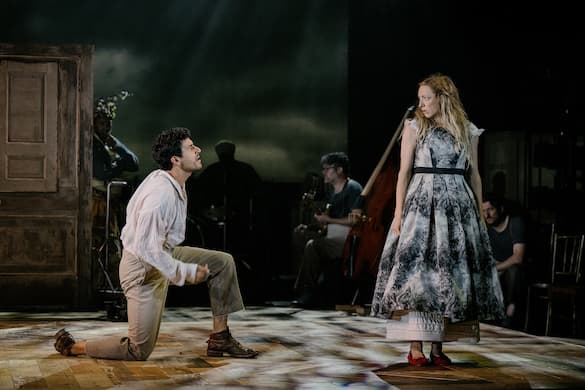If You’re Looking for Your Mother’s ‘Wuthering Heights,’ Look Elsewhere
Emma Rice’s adaptation skins away formality, exposing the manic, infernal heart beating behind Emily Brontë’s only novel.

As expectant audience members took their seats at St. Ann’s Warehouse, Brooklyn’s bastion of experimental theater, a light shone down upon a small package placed in the middle of the stage. It was a book shrouded in white paper, thrown forward in time from 1847, ready to unwrap itself. Emily Brontë’s beautiful gift to us.
If Wise Children’s adaptation of “Wuthering Heights” is anything, it is beautiful, calling to mind the second line of the manuscript spoken by the harried Mr. Lockwood, “This is certainly a beautiful country.”
Even in all its beauty, though, this is not your mother’s “Wuthering Heights.” Although much of the original text is masterfully grafted in, Emma Rice’s adaptation skins away formality, exposing the manic, infernal heart beating behind Brontë’s only novel. Ms. Rice brings her signature exuberance and physicality to the stage, transforming what is a lonely tale of two lovers to an ensemble piece.
The action is primarily driven by a group of actors who call themselves the Moors, a clear nod to the Fates in Broadway’s “Hadestown.” They are our expositors, our stagehands, our landscape incarnate, and our antiheroes’ constant companions. As in “Hadestown,” they are backed by a full folk band, playing new compositions by Ian Ross, and execute distinctive (if less precise) choreography. This is not a play, and not a musical either: It’s in a sort of no-man’s land best described as a dramatic operetta.
Gone are the “classic” casting choices — the innocent strings behind a dashing Laurence Olivier. There is no Ralph Fiennes to brood over a fragile Juliette Binoche. Not even Tom Hardy, a significant step up in the “weird” department, would fit this bill. Alastair Coomer and Sam Jones’s casting choices honor Brontë’s intent but embrace the creative casting trends of the modern day. Heathcliff, played by Liam Tamne, is of Indian descent, following cues in the text like, “dark skinned gypsy” and “a little Lascar” — a 19th century term referring to Indian sailors.
One of their modern, gender-bending choices was also one of their best. The protean Katy Owen made each of her appearances a highlight, moving seamlessly from Isabella Linton to Little Linton, and then to the Moors. Eleanor Sutton overcomes the pervasive darkness as Young Cathy with her gentle, insuppressible light.
Lucy McCormick, who plays Catherine Earnshaw, is her antithesis. She’s in constant torment, her face contorted into a Brechtian silent-scream more often than not. “I once had a dream I was in heaven,” she laments, “but it didn’t feel like home.” When her breakdown comes, we don’t quite believe it, just like we never quite root for Catherine and Heathcliff. The audience is left wondering: Is this because of their selfishness and depravity (they both revere the Roman emperor and “magnificent tyrant” Nero)? Is it a lack of dimension in their performances? Is it the necrophilic sex scene? Or is it something else?
For all of the stagecraft and laudable performances, the antiheroes’ wanting relationship sometimes mirrors the show as a whole. As I watched the players emulate the wind and don flower crowns and tangle themselves in jump ropes, I was chasing away thoughts of acting school — crawling on hands and knees as the professor told us to emulate our “favorite elements.” At times, we were watching a polished work of art. At others, it was as if we were watching the University of Michigan’s production of “Peter and the StarCatcher,” but with a budget.
The ending, however, overcomes any disbelief. Heathcliff and Catherine have died and are replaced by their offspring, who break generational cycles with color and kindness. Young Cathy puts a book in white wrapping and hands it to Hareton, her love, like a white flag. “Paper, not blood.” A gift from her to him. And from Emily to us.
“They halted to take a last look at the moon.” Everyone, even the dead, were finally at peace.

